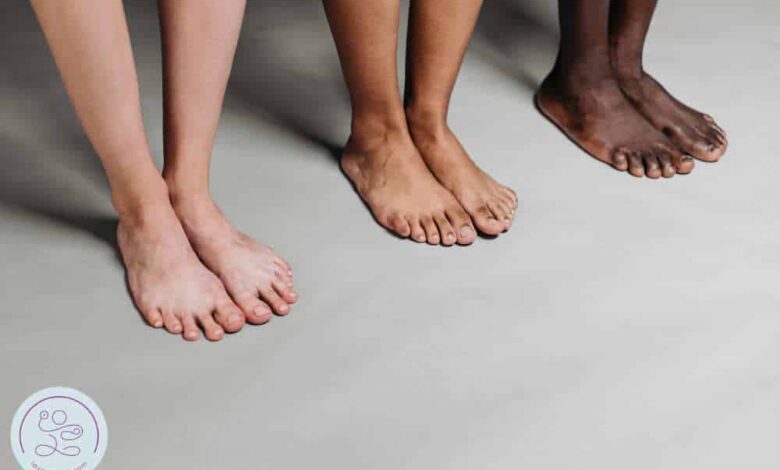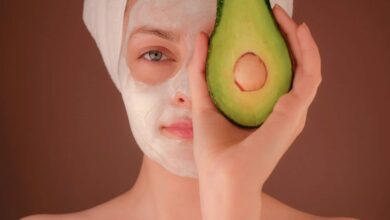Strong Glutes, Healthy Pelvic Floor: It Starts With The Feet!

After pregnancy, we emphasize strengthening the core and restoring healthy pelvic floor muscles.
But your feet are just as important!
Your feet affect your ENTIRE body.
They are important shock absorbers.
They set the foundation for all your movement patterns.
And they are your literal connection to the world, providing a wealth of sensory information that your brain uses to understand your place in the world.
If you want to reconnect with your body postpartum- Cultivating a deeper connection with your feet is a big chunk of that fat.
So let’s talk about how pregnancy affects your feet. And how, in turn, your feet affect my darlings, the glutes and pelvic floor.
The Foot Complex
Feet are the most complex part of the body. With more than 26 bones, 29 muscles and 33 joints, your feet quickly adapt to fast-moving terrain, loads and activities.
So let’s give credit where credit is due.
That said, it’s hard to talk about feet without using a lot of jargon.
They are incredibly complex. So while I’ll try to break it down, here’s a heads up that this one is getting deeper into the weeds of biomechanics.
But stick with me, it’s worth it 😉
Before getting too deep, let’s start with some really basic information about how your feet move:
What is Pronation and Supination?
When it comes to your feet, they need to be pronated and supinated.
These are the words you may have heard when you went to get fit for running shoes.
When your feet pronateyour arches get flatter. We say they are internal spinning
if you supinateyour arches get higher. They are exterior spinning
Both are necessary for full, healthy range of motion for the feet.
How Do Your Feet Affect Your Pelvic Floor?
Full range of motion in the leg is necessary for full range of motion in the hips, pelvis and their associated muscles (hellooooo glutes and pelvic floor!).
The feet affect the pelvic floor in at least two ways:
1) Through soft tissue
The arch of your foot and your pelvic floor are connected by webs of soft tissue called fascia.
Think about wearing a pair of pantyhose (does anyone still do this? But bear with me…). And then think about taking a pinch of fabric through your feet and twisting it. And turned it around. And turned it around.
Eventually you’ll start to pull the waist down, even as you twist and turn the leg fabric.
If the tissues in your feet are tight, your soft tissues will translate that tightness down to your pelvic floor.
2) Through rigid structures
Your feet connect to the pelvis through bones and leg joints.
The rotation of your feet dictates the way your tibia (shin bone) rotates.
Which in turn dictates how your femur (thigh bone) rotates.
Which determines how your pelvic bones rotate.
If your feet are stuck in a high archan externally rotated shape, that rotation will travel up the legs toward the hips and pelvis.
Your pelvis is likely to be biased in external rotation too.
A pelvis that is always externally rotated puts the pelvic floor in a short and tight position.
If you have flat feetyour pelvis is biased more internal rotation.
In an internally rotated pelvis, the pelvic floor can be “stuck” in a more extended position.
If the pelvic floor is stuck in a short position OR a long position, it cannot dynamically respond to changes in load during activities of daily living or exercise.
In an ideal scenario, the pelvic floor is flexible and has access to a full range of motion for optimal function.
But it’s not it just is the pelvic floor.
What is the Foot-Glute Connection?
Foot mobility also affects glute strength through its role in tilting rotation at the pelvis.
If you can’t pronate, for example, internal rotation at the hip (think: rotating your femur or thigh toward your midline) becomes difficult.

Internal rotation at the hip is necessary to find a good hip hinge.
To drop into a deep squat.
To load the legs while walking.
To create propulsion during athletic movements.
If you can’t pronate, and you can’t find internal rotation at the hip, the the buttock muscles become short and tight. In a chronically shortened state, they are less available and less effective.
Limited leg movement –> less strength in gluteal muscles.
How Does Pregnancy Affect Your Feet?
So, what does this have to do with pregnancy and postpartum?
1) During pregnancy, the pelvis rotates outward to accommodate the growing fetus and many people (certainly not all) notice that their feet also begin to turn outward.
You see this in the “pregnancy waddle”.
When the feet are out-turned, there is a tendency to get stuck in a “high-arch” or “supinated” position.
2) On the other hand, you may have noticed that your feet have grown during pregnancy. That includes flattening your arch.
Many people are really stuck with FLAT feet after pregnancy.
Although it is difficult to predict HOW feet will change during pregnancy, chances are good, they will be affected.
Between the shifting center of mass, relaxin-induced spreading of the legs and changes flowing down from the pelvis- the information we collect from our legs will look very different before and after pregnancy.
Restoring a solid mind-body connection in the feet is an important part of rehabbing a postpartum body.
Cultivate a Deeper Connection with Your Feet
The feet are the most complicated.
I’m just scratching my head here because I’m learning from you.
And what I know for sure, there is no single corrective for everyone.
So instead of offering an armchair diagnosis and specific corrective exercises, I want to offer you some SIMPLE tools that I’ve found work well for improving sensory awareness and mobility of the feet.
1) Take off your shoes.
Shoes limit your foot and ankle movement and they limit the sensory input you get from the ground.
Exercising without your shoes on will provide more sensory input from the ground and improve your proprioception. Your balance will improve as your foot movement improves.
And your mobility will improve while challenging the foot and lower leg muscles to respond to different surfaces and asymmetrical positions.
Taking off your shoes is low-hanging fruit- it’s the most passive way to improve your foot health.
I recommend using your strength training to experiment with spending time barefoot.

2) Find your tripod foot.
Think of your foot like a tripod, with three points of contact with the ground.
The tripod consists of your heel, the knuckle of your big toe, and the knuckle of your pinky toe.
Stand barefoot and consider your feet.
Can you feel all three points of contact?
Does the pressure feel evenly distributed across all three points of contact?
As you exercise, consider keeping your tripod foot on the ground. Especially during hinges, squats and split stance exercises (keep the stance foot grounded on the tripod).

3) Dynamic Foot Drill
Try this foot drill to become aware of how your foot dynamically responds to changes in your body position.
Technically, this is a pronation drill. An internal rotation drill.
This will allow you to feel your weight shift through your foot as you put your body weight on top of your foot.
This is also great practice for keeping your tripod foot on the ground as your weight shifts.
Work it slowly. If you do this too quickly, you will have a hard time feeling the weight shift on your foot.
Action Items
Whether through bone or through soft tissue- it’s clear that your feet, your pelvic floor and your glutes have a close relationship.
If you want strong glutes and a healthy pelvic floor that can respond reflexively to the demands of everyday life and exercise, it starts with good range of motion in the legs.
The simplest place to start is by simply spending more time taking off your shoes.
Let your feet move.
And spend some time cultivating a connection with your feet and bring more awareness to the points of contact you share with the earth.
If you want to take a full body, core and pelvic floor informed approach to your postpartum fitness, take a look Stronger Postpartum o connect with me to set up a time to talk 1:1 personal training.

My mission is to make sure that having a baby is not a reason why you can’t do all the things.
Laura Jawad has a PhD and a personal training certification (NASM). He is a proud man Certified Prenatal and Postnatal Coach and Pregnancy and Postpartum Athleticism Coach. You can check out the rest of his alphabet soup here.
follow @laurajawadfitness

Call me
Located just outside of Seattle in Redmond, WA
COPYRIGHT © 2023. LAURA JAWAD LLC | TERMS OF USE | PRIVACY POLICY | DISCLAIMER | SITEMAP
The post Strong Glutes, Healthy Pelvic Floor: It Starts With The Feet! first appeared on Laura Jawad.






